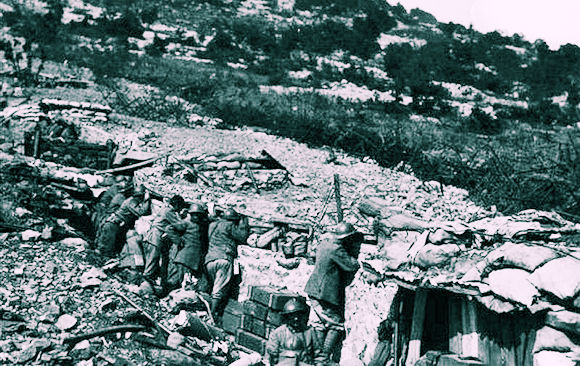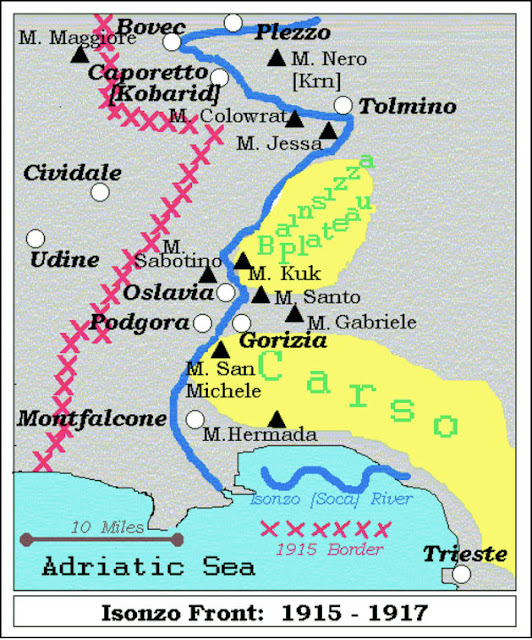The Carso or "Karst" is a barren limestone plateau partly in present-day Italy and partly in Slovenia, SE of Gorizia, that measures about 50 square miles. It is highly permeable resulting in high solubility and fissuration. This causes the formation of innumerable subterranean caves and sinkholes, often completely invisible. Numerous gullies crisscross the surface. A similar geologic formation, the Bainsezza Plateau, is just north of the Carso on the other side of the wooded Selva di Ternova. "Karst" has become a generic term used to describe similar rocky landscapes around the world.
War correspondent E. Alexander Powell described the Carso vividly:
Imagine a vast limestone plateau, varying in height from 700 to 2,500 feet, which is as treeless and waterless as the deserts of Chihuahua, as desolate and forbidding as the Dakota Bad Lands, with a surface as torn and twisted and jagged as the lava beds of Utah, and with a summer climate like that of Death Valley in July. That is the Carso.
 |
| A Frontline Italian Trench During the Fighting |
This great tableland of rock, which begins at Gorizia, approaches close to the shores of the Adriatic between Monfalcone and Trieste, and runs southeastward into Istria, links the Alpine system with the Balkan ranges. Its surface of naked, sun-flayed rock is broken here and there with gigantic heaps of piled stone, with caves and caverns, with sombre marshes which sometimes become gloomy and forbidding lakes, and with peculiar crater-like depressions called dolinas, formed by centuries of erosion. Such scanty vegetation as there is, is confined to these dolinas, which form the only oases in this barren and thirsty land. The whole region is swept by the Bora, a wind which is the enemy alike of plant and man. Save for the lizards that bask upon its furnace-like floors, the Carso is as lifeless as it is treeless and waterless. No bird and scarcely an insect can find nourishment over vast spaces of this sun-scorched solitude; even the hardy mountain grass withers and dies of a broken heart. So powerful is the sun that eggs can be cooked without a fire. Metal objects, such as rifles and equipment, when left exposed, quickly become too hot to touch. The bodies of the soldiers who fall on the Carso are not infrequently found to have been baked hard and mummified after lying for a day or two on that oven-like floor of stone.
The troops hated the area, describing the Carso as "a howling wilderness of stones sharp as knives." The summer wind was crushing and the winter featured a bitter wind they called the "Bora." It was through the Carso, however, that the Italian Army had to advance to capture its objective of Trieste. Many of the eleven battles of the Isonzo—all Italian offensives—had the Carso as a primary focus or a major diversion.
 |
| Looking North, the Mte. San Michele Sector As It Appears Today |
In August 1916 during the 6th Battle of the Isonzo, the commanding outpost of the Hungarian forces defending the Carso, Mte. San Michele, was captured by Italian forces at enormous cost. Much of the remainder of the plateau was captured during the 10th Isonzo in 1917, but again with severe casualties. Gas warfare was used extensively on the Carso making the fighting especially gruesome for both sides. During the Battle of Caporetto, the Carso was abandoned by Italy's Third Army under the Duke of Aosta. The region was reoccupied at the time of the Armistice.
 |
| Cave Used for Shelter by Hungarian Defenders |
The area around Mte. San Michele is now a sacred area and is a combination memorial and open-air museum with a small enclosed museum on the summit. A small village named San Martino, the site of an Austrian gas attack in June 1916, was destroyed in the war and later immortalized by Giuseppe Ungaretti's poem I Am a Creature, which he composed while serving nearby in August 1916. An enormous war memorial commemorating the battles on the plateau was opened in 1940 at Redipuglia and a large Austro-Hungarian cemetery is nearby at Fogliano. A tour of the Carso and the monuments around Redipuglia is a "must" for anyone visiting the Italian Front.


I've been thinking about the last line of this poem. Is it the idea that death is the main thing, and life is just a small, brief 'discount' we get, according to the poet? Or that death is no worse than the life he's leading? More than one possible meaning.
ReplyDeleteIt's a translation from the Italian of course, so the original meaning is even harder to decipher. But my immediate reaction on reading the line, is a postive one, that however difficult life is, it is still better than death; it challenges or negates death.
DeleteSorry The location on the map should read MONFALCONE not Montfalcone - I live close to it.
ReplyDeleteRedipuglia which is one of the war sanctuaries in the area was opened in the mid 1920s. The British representative Hugh Dalton was then asked where he had served by Mussolini (already PM) where he had served, and he replied here.